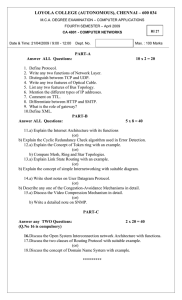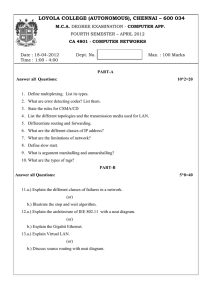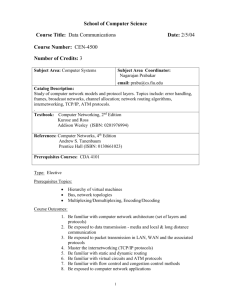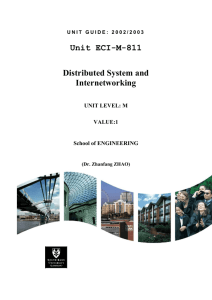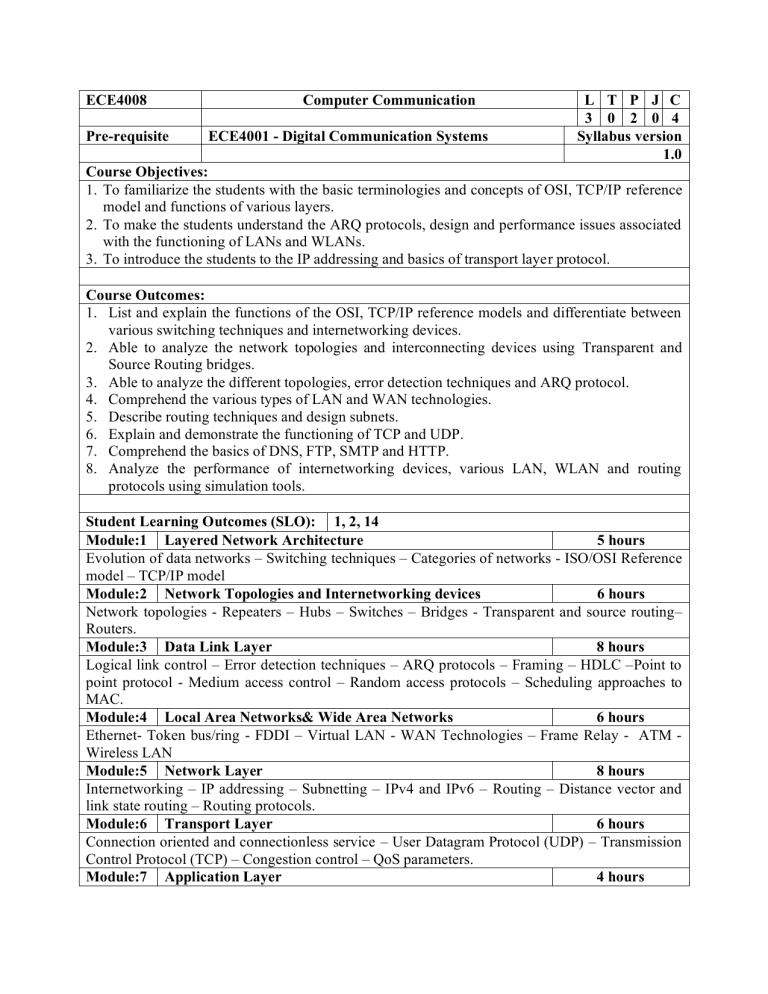
ECE4008 Pre-requisite Computer Communication ECE4001 - Digital Communication Systems L T P J C 3 0 2 0 4 Syllabus version 1.0 Course Objectives: 1. To familiarize the students with the basic terminologies and concepts of OSI, TCP/IP reference model and functions of various layers. 2. To make the students understand the ARQ protocols, design and performance issues associated with the functioning of LANs and WLANs. 3. To introduce the students to the IP addressing and basics of transport layer protocol. Course Outcomes: 1. List and explain the functions of the OSI, TCP/IP reference models and differentiate between various switching techniques and internetworking devices. 2. Able to analyze the network topologies and interconnecting devices using Transparent and Source Routing bridges. 3. Able to analyze the different topologies, error detection techniques and ARQ protocol. 4. Comprehend the various types of LAN and WAN technologies. 5. Describe routing techniques and design subnets. 6. Explain and demonstrate the functioning of TCP and UDP. 7. Comprehend the basics of DNS, FTP, SMTP and HTTP. 8. Analyze the performance of internetworking devices, various LAN, WLAN and routing protocols using simulation tools. Student Learning Outcomes (SLO): 1, 2, 14 Module:1 Layered Network Architecture 5 hours Evolution of data networks – Switching techniques – Categories of networks - ISO/OSI Reference model – TCP/IP model Module:2 Network Topologies and Internetworking devices 6 hours Network topologies - Repeaters – Hubs – Switches – Bridges - Transparent and source routing– Routers. Module:3 Data Link Layer 8 hours Logical link control – Error detection techniques – ARQ protocols – Framing – HDLC –Point to point protocol - Medium access control – Random access protocols – Scheduling approaches to MAC. Module:4 Local Area Networks& Wide Area Networks 6 hours Ethernet- Token bus/ring - FDDI – Virtual LAN - WAN Technologies – Frame Relay - ATM Wireless LAN Module:5 Network Layer 8 hours Internetworking – IP addressing – Subnetting – IPv4 and IPv6 – Routing – Distance vector and link state routing – Routing protocols. Module:6 Transport Layer 6 hours Connection oriented and connectionless service – User Datagram Protocol (UDP) – Transmission Control Protocol (TCP) – Congestion control – QoS parameters. Module:7 Application Layer 4 hours Domain Name System (DNS) – Simple Mail Transfer Protocol (SMTP) – File Transfer Protocol (FTP) – Hypertext Transfer Protocol (HTTP) - World Wide Web (WWW) Module:8 Contemporary Issues 2 hours Total lecture hours: 45 hours Text Book(s) 1. Alberto Leon-Garcia, “Communication Networks”, 2013, 2 nd edition, Tata McGraw-Hill, USA. Reference Books 1. Robert Gallager, “Data Networks”, 2013, 2 nd edition, Prentice Hall, USA. 2. W. Stallings, Data and Computer Communications, 2013, 8 th edition, Pearson Prentice Hall, USA. 3. Behrouz A Forouzan, “Data Communications and Networking”, 2012, 5 th edition, Tata McGraw-Hill, USA. Mode of evaluation: Internal Assessment (CAT, Quizzes, Digital Assignments) & Final Assessment Test (FAT) List of Challenging Experiments (Indicative) 1 1. Create a simple network model with multiple scenarios, collect statistics on network performance through the use of simulation tools, analyze statistics and draw conclusions on network performance. 2. Performance analysis of layer 1 and layer 2 (physical and data link layer) devices in LAN. 3. Compare the throughput and delay of a Local Area Network interconnected by a switch by creating a switched LAN with __4_____ nodes. Assume voice traffic and use the voice codec standards G.711, G.723 and G.729. Also analyze the voice custom traffic for the throughput of 200 kbps and 64 kbps 2 Analyse the spanning tree algorithm by varying the priority among the switches: 1. Observe and explain the default behavior of spanning tree protocol (STP, 802.1D) 2. Observe the response to a change in the spanning tree topology 3 Analyze IPV4 using Class A, B & Class C. 4 An ISP is granted a block of addresses starting with 190.100.0.0/24 (65,536 addresses). The ISP needs to distribute these addresses to three groups of customers as follows: 1. The first group has 64 customers; each needs 256 addresses. 2. The second group has 128 customers; each needs 128 addresses. 3. The third group has 128 customers; each needs 64 addresses. Design the subnetting of sub blocks and find out how many addresses are still available after these allocations. 5 Examine the network and 1. Identify connectivity problems- Use the ping command to test network connectivity. 6 hours 4 hours 4 hours 4 hours 4 hours 2. Troubleshoot network connections 3. Begin troubleshooting at the host connected to the router. 4. Examine the router to find possible configuration errors. 5. Use the necessary commands to correct the router configuration. 6. Verify the logical configuration. 6 Configure, apply real-time routing protocols (RIP/OSPF) in a simple network topology and analyze the routing tables and check the network connectivity 7 Recommend suitable Queuing mechanism among the following 1.First - In - First - out 2.Priority Queuing 3.Weighted Fair Queuing for Voice, Video & Custom traffic by creating a network using nodes, switches & routers using NETSIM Tool. Total laboratory hours Mode of evaluation: Continuous Assessment & Final Assessment Test (FAT) Recommended by Board of Studies 13/06/2015 Approved by Academic Council No. 37 Date 4 hours 4 hours 30 hours 16/06/2015

![Internetworking Technologies [Opens in New Window]](http://s3.studylib.net/store/data/007474950_1-04ba8ede092e0c026d6f82bb0c5b9cb6-300x300.png)


